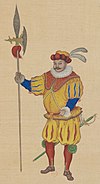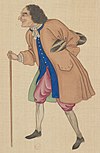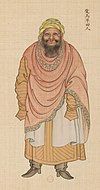Huang Qing Zhigong Tu ( Chinese: 皇清職貢圖; Collection of Portraits of Subordinate Peoples of the Qing Dynasty) is an 18th-century ethnological study of Chinese tributary states, including Western nations that traded with the Qing Empire. [1] [2] It was published around 1769. [2] The book identified peoples and countries by drawing attention to their national dresses, similarly to European costume books. [3]
The study contained numerous factual errors, such as reporting that France was a Buddhist state before becoming Catholic, that England and Sweden were vassals of Holland, and that France (Falanxi) and Portugal (Folangji) were the same country. [4]
Gallery
-
Man of the Great Western Ocean (Italy or Portugal)
-
Man of the province of Helvetia (Heleiweijiya sheng), of the Great Western Ocean (Europe)
-
Man of Hungary (Wengjialiya) in the Great Western Ocean
-
Man of Poland (Boluniya) in the Great Western Ocean
-
Man of England (Yingjili)
-
Man of France (Falanxi)
-
Man of Sweden (Rui)
-
Official of Russia (Eluosi)
-
Muslim man from Afghanistan (愛烏罕回人). Huang Qing Zhigong Tu, 1769
-
"Qiakala" people (恰喀拉), Qing designation of the Udege people. Huang Qing Zhigong Tu, 1769
-
Tayiji (prince) of the Torghuts and his wife (土爾扈特台吉). Huang Qing Zhigong Tu, 1769.
See also
References
- ^ Daston, Lorraine; Vidal, Fernando (2010). The Moral Authority of Nature. University of Chicago Press. p. 422. ISBN 9780226136820.
- ^ a b Teng, Emma (2006). Taiwan's Imagined Geography: Chinese Colonial Travel Writing and Pictures, 1683-1895. Harvard Univ Asia Center. p. 5. ISBN 9780674021198. Retrieved 10 February 2018.
- ^ Hostetler, Laura (2016). Managing Frontiers in Qing China: The Lifanyuan and Libu Revisited. BRILL. p. 186. ISBN 9789004335004.
- ^ Smith, Richard J. (2013). Mapping China and Managing the World: Culture, Cartography and Cosmology in Late Imperial Times. Routledge. p. 76. ISBN 9781136209215.
- ^ 伊犂等處台吉
Huang Qing Zhigong Tu ( Chinese: 皇清職貢圖; Collection of Portraits of Subordinate Peoples of the Qing Dynasty) is an 18th-century ethnological study of Chinese tributary states, including Western nations that traded with the Qing Empire. [1] [2] It was published around 1769. [2] The book identified peoples and countries by drawing attention to their national dresses, similarly to European costume books. [3]
The study contained numerous factual errors, such as reporting that France was a Buddhist state before becoming Catholic, that England and Sweden were vassals of Holland, and that France (Falanxi) and Portugal (Folangji) were the same country. [4]
Gallery
-
Man of the Great Western Ocean (Italy or Portugal)
-
Man of the province of Helvetia (Heleiweijiya sheng), of the Great Western Ocean (Europe)
-
Man of Hungary (Wengjialiya) in the Great Western Ocean
-
Man of Poland (Boluniya) in the Great Western Ocean
-
Man of England (Yingjili)
-
Man of France (Falanxi)
-
Man of Sweden (Rui)
-
Official of Russia (Eluosi)
-
Muslim man from Afghanistan (愛烏罕回人). Huang Qing Zhigong Tu, 1769
-
"Qiakala" people (恰喀拉), Qing designation of the Udege people. Huang Qing Zhigong Tu, 1769
-
Tayiji (prince) of the Torghuts and his wife (土爾扈特台吉). Huang Qing Zhigong Tu, 1769.
See also
References
- ^ Daston, Lorraine; Vidal, Fernando (2010). The Moral Authority of Nature. University of Chicago Press. p. 422. ISBN 9780226136820.
- ^ a b Teng, Emma (2006). Taiwan's Imagined Geography: Chinese Colonial Travel Writing and Pictures, 1683-1895. Harvard Univ Asia Center. p. 5. ISBN 9780674021198. Retrieved 10 February 2018.
- ^ Hostetler, Laura (2016). Managing Frontiers in Qing China: The Lifanyuan and Libu Revisited. BRILL. p. 186. ISBN 9789004335004.
- ^ Smith, Richard J. (2013). Mapping China and Managing the World: Culture, Cartography and Cosmology in Late Imperial Times. Routledge. p. 76. ISBN 9781136209215.
- ^ 伊犂等處台吉









![Mongol Dzungar Prince (Taiji) from Ili and other regions, and his wife. Huang Qing Zhigong Tu, 1769.[5]](https://upload.wikimedia.org/wikipedia/commons/thumb/b/b3/Ili_region_Taiji_%28Mongol_Prince%29_and_his_wife%2C_Huang_Qing_Zhigong_Tu%2C_1769.jpg/100px-Ili_region_Taiji_%28Mongol_Prince%29_and_his_wife%2C_Huang_Qing_Zhigong_Tu%2C_1769.jpg)

